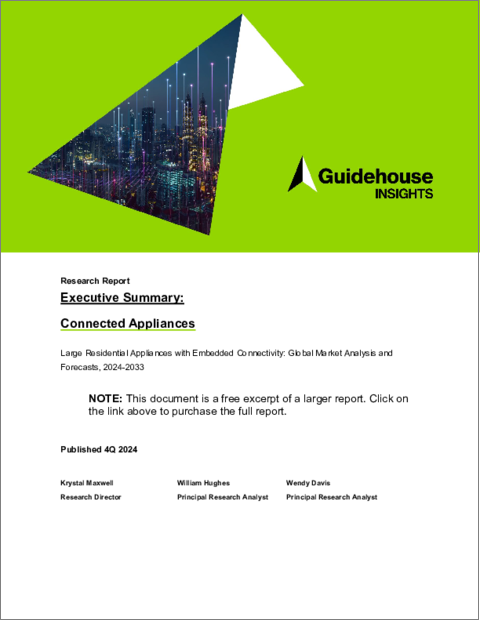|
|
市場調査レポート
商品コード
1640750
コネクテッド家電市場 - コネクティビティを内蔵した大型住宅用家電:世界市場の分析と予測(2024年~2033年)Connected Appliances - Large Residential Appliances with Embedded Connectivity: Global Market Analysis and Forecasts, 2024-2033 |
||||||
|
|||||||
| コネクテッド家電市場 - コネクティビティを内蔵した大型住宅用家電:世界市場の分析と予測(2024年~2033年) |
|
出版日: 2024年12月12日
発行: Guidehouse Research
ページ情報: 英文 37 Pages
納期: 即納可能
|
全表示
- 概要
- 目次
数十年前、Wi-Fiを搭載した最初のモデルが小売店で販売されたとき、大型家電のスマートホームへの統合は多くの利害関係者の想像力をかき立てました。数年も経たないうちに、多くの家電メーカーが特定のハイエンド製品ラインに接続性を提供するようになっています。しかし、家電製品のコネクティビティは、その宣伝文句に見合うものにはなっていません。
コネクテッド家電展望は控えめです。メーカー各社は、最先端でないという非難を避けるために、その普及の遅れとは関係なく、商品化に際して言及される機能としてコネクティビティを盛り込み続けるかもしれません。しかし、現在のコネクテッド家電の導入は、顧客満足をあまり生まず、エネルギー効率も向上させず、この状況に対処する努力は漸進的なものです。
コネクティビティにはいくつかの促進要因があります。一部の家電製品では遠隔操作や通知が可能になっていますが、顧客はこれらの機能にはほとんど無関心であり、その価値は安全性の懸念によって制限されています。コネクティビティが可能にするその他の価値ある機能は、トラブルシューティングの支援強化や、家庭用エネルギー管理システム(HEMS)との情報共有ですが、メーカーは現在これらのオプションを提供していません。安全性、セキュリティ、利便性の向上とエネルギー・コストの削減を約束する、接続された家電製品を含む、ターゲットを絞ったスマート・ホーム・アプリケーションは、接続性の採用率が低い間は芽を出す機会がない状態です。
家電メーカーの中には、家電製品のコネクティビティの推進に倍加的に取り組んでいるところもあります。顧客が家電製品をどのように使用しているかを追跡し、最も人気のある機能を強化することができれば、メーカーに利益がもたらされます。メーカーは、家庭がどのように家電製品を使用しているかという情報を収集することもできます。AIを使えば、メーカーは家電の使用情報を使ってライフスタイルのパターンを推測することができ、それを他社に販売することで、見込み客のターゲティングを強化することができます。
家電の制御と通知のためにWi-Fi接続を維持するという現状は、いつまでも続くかもしれません。しかし、より大きなスマートホーム・エコシステム内の他の企業は、これまでコネクテッド家電に関連していた機能のいくつかに対応する可能性のある代替技術を提供し始めています。革新的で資金力のある企業数社が、この分野で積極的に競争しています。彼らの成功が続けば、エネルギー管理のための家電接続はますます意味をなさなくなると予測されています。
当レポートでは、コネクテッド家電市場について調査し、市場の概要とともに技術動向、競合情勢、市場の予測、地域別動向などをまとめています。
目次
第1章 エグゼクティブサマリー
第2章 市場の問題
- 市場概要
- 技術
- 掃除用コネクテッド家電
- 食品の保存と調理のためのコネクテッド家電
- 家電の接続オプション
- 市場促進要因
- 市場抑制要因
- 価格
第3章 産業バリューチェーン
- 競合情勢
第4章 市場予測
- 調査手法
- 世界の予測
- 地域別予測
- 北米
- 欧州
- アジア太平洋
- ラテンアメリカ
- 中東・アフリカ
第5章 結論・提言
第6章 頭字語と略語一覧
第7章 目次
第8章 図表
第9章 調査範囲、情報源と調査手法、注釈
The integration of large appliances within a smart home sparked the imaginations of many stakeholders when the first models with Wi-Fi became available at retail a few decades ago. Within a few years, many appliance manufacturers were offering connectivity for certain high end product lines. However, connectivity for appliances has failed to live up to its hype.
The prospects for connected appliances are modest. Manufacturers may continue to include connectivity as a feature mentioned in merchandising, regardless of its lack of adoption, to avoid the accusation of not being state-of-the-art. But the current implementation of connected appliances does not generate much customer satisfaction or increase energy efficiency, and efforts to address this situation have been incremental.
Several drivers are associated with connectivity. Remote control and notification have been enabled on some appliances, but customers are largely unexcited about these capabilities and their value is limited by safety concerns. Other valuable capabilities that connectivity could enable are enhanced troubleshooting assistance and information sharing with home energy management systems (HEMS), but manufacturers do not currently offer these options. Narrowly targeted smart home applications involving connected appliances that promise greater safety, security, and convenience and lower energy costs have not had the chance to germinate while the adoption of connectivity is low.
Some appliance manufacturers are doubling down on promoting appliance connectivity. Benefits accrue to manufacturers when they can track how customers use the appliance and enhance the most popular features. Manufacturers can also collect information on how a household uses appliances. With AI, manufacturers can use information on household appliance usage to draw inferences about lifestyle patterns, which can be sold to other companies for better targeting of prospective customers.
The status quo of keeping Wi-Fi connectivity for appliance control and notification might continue indefinitely. However, other companies within the greater smart home ecosystem are starting to offer alternative technologies that have the potential to address some of the capabilities previously associated with connected appliances. Several innovative and well-financed companies are competing aggressively in this area. If their success continues, Guidehouse Insights expects appliance connectivity for energy management to become increasingly less relevant.
Table of Contents
1. Executive Summary
- 1.1 Market Forecast
2. Market Issues
- 2.1 Market Overview
- 2.2 Technologies
- 2.2.1 Connected Appliances for Cleaning
- 2.2.2 Connected Appliances for Food Preservation and Preparation
- 2.2.3 Connectivity Options for Appliances
- 2.3 Market Drivers
- 2.3.1 Current Drivers for Appliance Users
- 2.3.2 Current Drivers for Appliance Manufacturers
- 2.3.3 Latent Drivers with Potential to Encourage Greater Adoption
- 2.4 Market Barriers
- 2.5 Pricing
3. Industry Value Chain
- 3.1 Competitive Landscape
4. Market Forecasts
- 4.1 Methodology
- 4.2 Global Forecasts
- 4.2.1 Equipment Type
- 4.2.2 Building Type
- 4.2.3 Construction Type
- 4.3 Regional Forecasts
- 4.3.1 North America
- 4.3.2 Europe
- 4.3.3 Asia Pacific
- 4.3.4 Latin America
- 4.3.5 Middle East & Africa
5. Conclusions and Recommendations
- 5.1 Three Big Takeaways
- 5.2 Recommendations
- 5.2.1 Appliance Manufacturers
- 5.2.2 Home Energy Management Suppliers
- 5.2.3 Smart Home Software and Connectivity Vendors






